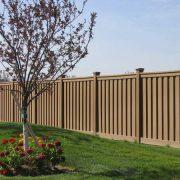How to decorate a chain link fence
The silver wire fence is very useful for marking the boundaries of many residences, government buildings and businesses. Typically strong and functional, the wire mesh is not intended to be a decorative material. To ensure your privacy, you can place vines with abundant foliage and fragrant flowers in it. If you choose to cover your fence with an evergreen plant, like English ivy, you can also add some seasonal details to add a touch of visual interest. Moreover, the coated wire mesh is also a practical, simple and good looking option.
Instructions
Climbing plants
- Select a few climbing plants that suit the location in the sun or shade of your chain link fence. Some climbing species with flowers like roses, wisteria and sweet peas prefer sunny places. Vines like English ivy, honeysuckle and Virginia creeper tolerate dense shade.
- Prepare several holes separated by about 6 inches (15 centimeters). Make sure that the holes are at least two times deeper and wider than the root of the individual plants that are going to be planted or transplanted. Mix a shovelful of compost material in the excavated soil. This mixture is known as “base fill”. Loosen the soil at the bottom and sides of the hole and water until evenly wet.
- Place the plants in the holes, spreading the roots gently. Cover the root knot completely with the mixture of soil and compost material and water well. Help guide the branches of the vine to the fence with a rope made of natural fibers as they grow.
- As the seasons are changing, add some decorative outdoor details. Choose a large wreath illuminated by a series of lights during major winter days and a mass of flowers, as they can be hyacinths, daffodils and artificial tulips for spring. Consider adding a colorful collection of beach toys for the summer. Secures objects to mesh with a piece of natural rope.
Plastic strips to close
- Measure the width and length of the area you’d like covered and multiply these numbers to get the total area of the billboard. This is essential when buying plastic strips. This material blocks almost all the view from the outside as it is specially designed for this purpose. You will need approximately 250 feet (76 m) of plastic strips weaved diagonally across each link in the mesh, and thus completely covering an area of about 40 square feet (3.72 m).
- Give it a custom look by using strips of color of your university or corporate logo. This material can be achieved by special ordering the color and design you want. –Verde Standard colors, black and White– are available in stores and online major home improvement stores. Try to choose strips of colors and designs that complement the style of your property. Even just using two colors, you can create some pretty creative designs.
- Diagonally measure the distance from the top of the fence to the base, using the measuring tape and extending directly along the links line. Remember that you must weave a single strip of plastic on each of the links of each diagonal fence row. Once the length of the line is determined, cut a strip of this size and weave through the links. Pay attention to the way you work and try to leave the fabric loose enough to carry comfortably before continuing the weave. Alternating strips of plastic canvas fragments create business privacy screens. They can serve to represent foliage. Choose warm neutral colors simulate a natural environment.
Tips & Warnings
- For holidays and special occasions, decorate your mesh fence with white or colored flashing lights.
- Keep your plants carefully trimmed. The overgrowth can lead to insects and other animals.






